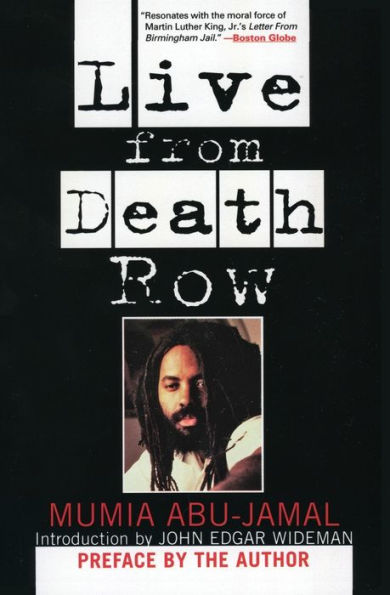Read an Excerpt
Chapter One
Teetering on the brink between life and deathFor there to be equivalence, the death penalty would have to punish a criminal who had warned his victim of the date at which he would inflict a horrible death on him and who, from that moment onward, had confined him at his mercy for months. Such a monster is not encountered in private life.
--ALBERT CAMUS
"Yard in!"
The last yard of the day is finally called. "Capitals! Fourth, fifth, and sixth tier--YARD UP!" the corpulent correctional officer bellows, his rural accent alien to the urban ear.
One by one, cells are unlocked for the daily trek from cell to cage. Each man is pat-searched by guards armed with batons and then scanned by a metal detector.
Once the inmates are encaged, the midsummer sky rumbles, its dark clouds swell, pregnant with power and water. A bespectacled white-shirt turns his pale face skyward, examining nature's quickening portent. The rumbles grow louder as drops of rain sail earthward, splattering steel, brick, and human.
"Yard in!" the white-shirt yells, sparking murmurs of resentment among the men.
"Yard in?! Shit, man, we just got out here!"
The guards adopt a cajoling, rather than threatening, attitude. "C'mon, fellas--yard in, yard in. Ya know we can't leave y'uns out here when it gits to thunderin' an' lightnin'."
"Oh, why not? Y'all 'fraid we gonna get our-self electrocuted?" a prisoner asks.
"Ain't that a bitch?" another adds. "They must be afraid that if we do get electrocuted by lightnin', they won't have no jobs and won't get paid!"
A few guffaws, and the trail from cage to cellthickens.
Although usually two hours long, today's yard barely lasts ten minutes, for fear that those condemned to death by the state may perish, instead, by fate.
For approximately twenty-four hundred people locked in state and federal prisons, life is unlike that in any other institution. These are America's condemned, who bear a stigma far worse than "prisoner." These are America's death row residents: men and women who walk the razor's edge between halflife and certain death in thirty-four states or under the jurisdiction of the United States. The largest death row stands in Texas (324 people: 120 African-Americans, 144 whites, 52 Hispanics, 4 Native Americans, and 4 Asian-Americans); the smallest are in Connecticut (2 whites), New Mexico (1 Native American, 1 white), and Wyoming (2 whites).
You will find a blacker world on death row than anywhere else. African-Americans, a mere 11 percent of the national population, compose about 40 percent of the death row population. There, too, you will find this writer.
Control
It is from Pennsylvania's largest death row at the State Correctional Institute at Huntingdon, in rural south-central Pennsylvania, that I write. In the Commonwealth I am but one of 123 persons who await death. I have lived in this barren domain of death since the summer of 1983. For several years now I have been assigned DC (disciplinary custody) status for daring to abide by my faith, the teachings of John Africa, and, in particular, for refusing to cut my hair.* For this I have been denied family phone calls, and on occasion I have been shackled for refusing to violate my beliefs.
Life here oscillates between the banal and the bizarre.
Unlike other prisoners, death row inmates are not "doing time." Freedom does not shine at the end of the tunnel. Rather, the end of the tunnel brings extinction. Thus, for many here, there is no hope.
As in any massive, quasi-military organization, reality on the row is regimented by rule and regulation. As against any regime imposed on human personality, there is resistance, but far less than one might expect. For the most part, death row prisoners are the best behaved and least disruptive of all inmates. It also is true, however, that we have little opportunity to be otherwise, given that many death units operate on the " 22 + 2" system: 22 hours locked in cell, followed by 2 hours of recreation out of cell. Outdoor recreation takes place in a cage, ringed with double-edged razor wire-the "dog pen."
All death rows share a central goal: "human storage" in an "austere world in which condemned prisoners are treated as bodies kept alive to be killed."
Pennsylvania's death row regime is among America's most restrictive, rivaling the infamous San Quentin death unit for the intensity and duration of restriction. A few states allow four, six, or even eight hours out of cell, prison employment, or even access to educational programs. Not so in the Keystone State.
Here one has little or no psychological life. Here many escape death's omnipresent specter only by way of common diversions-television, radio, or sports. TVs are allowed, but not typewriters: one's energies may be expended freely on entertainment, but a tool essential for one's liberation through judicial process is deemed a security risk.
One inmate, more interested in his life than his entertainment, argued forcefully with prison administrators for permission to buy a nonimpact, nonmetallic, battery-operated typewriter. Predictably, permission was denied for security reasons. "Well, what do y'all consider a thirteen-inch piece of glass?" the prisoner asked. "Ain't that a security risk?"
"Where do you think you'll get that from?" the prison official demanded.
"From my TV!"



